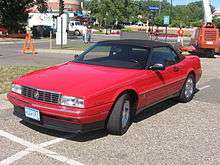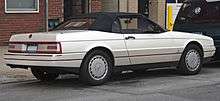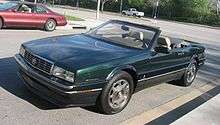Cadillac Allanté
| Cadillac Allanté | |
|---|---|
 | |
| Overview | |
| Manufacturer |
Cadillac (General Motors) Pininfarina (body) |
| Production | 1986–1993 |
| Assembly |
San Giorgio Canavese, Italy Detroit/Hamtramck Assembly (Detroit, Michigan) |
| Designer | Pininfarina |
| Body and chassis | |
| Class | Luxury roadster |
| Body style | 2-door convertible |
| Layout | FF layout |
| Platform | V-body |
| Powertrain | |
| Engine |
4.1 L HT-4100 V8 4.5 L HT-4500 V8 4.6 L Northstar V8 |
| Transmission |
4-speed 4T60 automatic 4-speed 4T80 automatic |
| Dimensions | |
| Wheelbase | 99.4 in (2,525 mm) |
| Length |
1987–89: 178.6 in (4,536 mm) 1990–93: 178.7 in (4,539 mm) |
| Width |
1987–1991: 73.5 in (1,867 mm) 1992–93: 73.4 in (1,864 mm) |
| Height |
1987–1991 52.2 in (1,326 mm) 1992–93: 51.5 in (1,308 mm) |
| Curb weight | 3,720 lb (1,690 kg) |
| Chronology | |
| Successor | Cadillac XLR |
The Cadillac Allanté is a two-door, two-seater roadster marketed by Cadillac from 1986 until 1993, with roughly 21,000 units built over a seven-year production run.
Overview
Originally designed to compete with the Mercedes-Benz SL and Jaguar XJS, the Allanté featured a slightly modified variant of the 4.1 liter V8 used across Cadillac's model line.
The Allanté is noted for an unusual production arrangement, where completed bodies — designed and manufactured in Italy by Pininfarina —[1] were shipped 4,600 mi (7,400 km) from Italy in specially equipped Boeing 747s, 56 at a time,[1] to Cadillac's Detroit/Hamtramck Assembly plant where they were mated with domestically manufactured chassis and engine assemblies.[1] Bodies had to be flown from the Turin International Airport in Italy to Detroit's Coleman A. Young International Airport, about 3 miles northeast of the new Hamtramck factory, known as the "Allante Air Bridge".[2][3] The expensive shipping process was implemented because GM had recently closed the Fisher Body Plant #18 which traditionally supplied Cadillac bodies since 1921. This was not the first time that Cadillac turned to Pininfarina for body work, they previously farmed out body production to the Turin-based coachbuilder for the 1959 Eldorado Brougham, as well as that for several one-offs, customs, and concept cars.
The name Allanté was selected by General Motors from a list of 1700 computer generated names.[4]
1987
The 1987 Allanté featured a removable aluminum hardtop, the industry's first power retractable AM/FM/Cellular Telephone antenna and a multi-port fuel injected variant of GM's aluminum 4.1 L (250 cu in) HT-Cadillac 4100 V8, along with roller valve lifters, high-flow cylinder heads, and a tuned intake manifold. The roadster featured an independent strut-based suspension system front and rear, Bosch ABS III four-wheel disc brakes and a complex lamp-out module that substituted a burned-out bulb in the exterior lighting system with an adjacent lamp until correction of the problem. The Delco-GM/Bose Symphony Sound System – a $905 option on other Cadillacs – was standard on Allanté. The only option was a cellular telephone, installed in a lockable center console.
1988
For 1988, the Allanté featured revised front seat headrests, and a power decklid pulldown as standard equipment. Analog instruments, in place of the standard digital dash cluster, were also now available as a no-charge option. The base price was raised to $56,533, with the cellular telephone still being the only extra-cost option.

1989
In 1989, the price rose to $57,183. Allanté's engine, the new 273ci (4.5L) V8, produced 200 horsepower, and with 270 lb·ft (366 N·m), it provided the most torque from any front-wheel-drive automobile in the world. Unlocking the trunk also unlocked the side doors – similar to Mercedes-Benz and BMW. As a theft-deterrent, Allanté added GM's Pass Key (Personal Automotive Security System), utilizing a resistor pellet within the ignition key that has the ability to render the fuel system and starter inoperative if an incorrect ignition key is used. Allanté also received a new speed-sensitive damper system called Speed Dependent Damping Control, or SD²C. This system firmed up the suspension at 25 mph (40 km/h) and again at 60 mph (97 km/h). The firmest setting was also used when starting from a standstill until 5 mph (8.0 km/h). Another change was a variable-assist steering system.
1990
In 1990, Cadillac offered a lower-priced ($53,050) companion model with a cloth convertible roof and without the removable aluminum hardtop, and a model including the hardtop at $58,638. By midyear, prices were dropped to $57,813 for the hardtop/convertible and $51,500 for the convertible, which included a $650 Gas Guzzler Tax along with $550 destination charge. The fully integrated cellular telephone, which was equipped from the factory on just 36 cars this year, was available for an additional $1,195. Allanté's bumper-to-bumper new car warranty, seven years and 100,000 mi (160,000 km), was three years longer than other Cadillacs, and an additional 50,000 mi (80,000 km) of coverage. Allanté owners also received a special toll-free number to call for service or concerns. Headlamp washers and dual 10-way Recaro seating remained standard, among other niceties. A driver's side airbag was added to the leather-wrapped steering wheel, eliminating the telescoping steering wheel — which retained its tilt feature. The analog instrument cluster – introduced the previous year – was standard on the convertible (available at no extra cost on the hardtop/convertible), however, only 358 cars were equipped with the analog cluster. The power mirror control moved from the right of the steering column on the instrument panel to a new location on the upper end of the driver's door armrest, while the power seat switches (previously mounted on the face of the seat base) were relocated to the lower side trim of the seat base facing the door panels. The 3-channel garage door opener base mounted on the header panel above the windshield was eliminated when a revamped sun visor design was introduced this year. Technological news was the addition of traction control – the first front-wheel drive automobile with a V8 in the world to be equipped as such. The elaborate system was able to cut fuel to up to four cylinders to reduce power and optimize traction. The electronically controlled shock absorbers were retuned to remain in "soft" mode for up to 40 mph (64 km/h). Previously, they entered "normal" mode after just 25 mph (40 km/h). A revised audio system allowed a CD player to be added as standard equipment, along with the cassette player. Of the 2,523 built for 1990, only five were exported – four to Canada and one to Germany. Allanté was available in eight colors this year, the most popular was Euro Red, found on 1,012 cars, while the least chosen was Gray Metallic, with only 28 made. Interior color choices (and production figures) were Charcoal Gray (1,343), Natural Beige (767), and Maroon (413).
1991

In 1991, Cadillac added a power-latching mechanism for the convertible top, and the digital instrument cluster, featured in all but 275 Allanté models this year, was repriced (it was now a $495 option for the convertible model). Prices began at $57,260, although a midyear price-drop brought the Allanté convertible down to $55,900, and the hardtop/convertible down to $61,450 (from $62,810). Allanté had 16.3 cubic feet of storage (when utilizing the pass-through compartment into the cabin area). Of the 1,928 models produced for 1991, only seven were manufactured for export – five to Canada, one to Italy, and another to Puerto Rico. Canadian models offered a kilometer-based instrument cluster, daytime running lamps, and an engine block heater as standard equipment, while the Italian model featured a list of European-mandated modifications, including breakaway side mirrors, specific European headlamps and turn signals, a front tow hook, rear fog lamps, deletion of the deck-lid mounted center brake light, a wet-arm windshield washer system, coolers for the power steering and automatic transmission fluids, and a revised steering column to compensate for the removal of the driver's airbag.
1992

The Allanté for 1992 was priced at $58,470 for the convertible, and $64,090 for the hardtop/convertible. Both prices included the mandated gas guzzler tax, which was now at $1,300. As it had been the custom for a few years now, price drops were announced midyear, $57,170 for the convertible, and $62,790 with the removable hardtop. The optional digital cluster was priced at $495 (available at no charge on the removable hardtop model), however, only 187 cars were equipped with the standard analog cluster this year. Also available on the convertible at extra-cost, a pearl white paint group (option YL3) priced at $700 (found on 443 models for 1992). This was the last year of the multi-adjustable Recaro seating design, as 1993 would go into production with less expensive Lear-designed eight-way dual power seats. Of the 1,698 produced this year, only four of them were specifically built for export – all of them to Canada. As with the previous year, the most popular exterior, found on 549 models, was 47U – Euro Red, while only 15 were made in 49U – Light Blue Metallic. Three shades of leather were available for the interior, the colors and production totals are: Charcoal (859), Natural Beige (652), and Maroon (187).and (50) Polo Green and Pearl Flax, (O4U) there was only one made in 1992.
1993
Introduced in early 1992 for the 1993 model year, Allanté was scaled down to just one model this year, the soft-top convertible priced at $59,975 (not including a mandatory $1,700 gas guzzler tax for vehicles sold in the United States). The removable 60.5 lb (27.4 kg). aluminum hardtop was now a separate option, as well as the $495 LCD digital instrument cluster in place of the standard analog instruments. A $700 pearlcoat paint option (in Flax or Canyon Yellow, with Hawaiian Orchid added midyear) was available. Also optional were chrome squeeze-cast aluminum wheels. For its final model year, Allanté received the 4.6 L (280.7 cu in) Northstar DOHC V8 engine. This engine was rated at 295 hp (220 kW) at 5600 rpm. Torque output was 290 ft·lb (390 N·m) at 4400 rpm. A new unequal-length control arm rear suspension, shared with the Seville and Eldorado, was also introduced that year. Also new for the small Cadillacs was Road Sensing Suspension, an active damper management system, and revised disc brakes. The 1993 model used GM's Delco "Premium Symphony Sound System". Other changes for the Allanté included a revised variable-assist power steering rack, deeper front spoiler, and single-piece side windows, which did away with the stationary forward vent window. Production for 1993 was the highest. Of the 4,670 Allantés manufactured for the 1993 model year, 115 were for export – France (1), Austria (2), Belgium (5), Germany (5), Switzerland (6), Japan (11), and Canada (85).
The 1993 Allante was also chosen as the 1992 pace car for the 76th Indy 500 Indianapolis 500, the pace car was driven by Bobby Unser. There were three modified 1993 Allante Pace Cars that had only seat belts, lighted roll bar, and air intake modified from a stock production Allante's, those three Allante Pace cars were provided for the race, as well as just 30 stock 1993 Allante's used as Festival/Pace Cars and 58 stock 1992 Allante Festival/Pace cars that were used by drivers and crews at the opening parade and the closing of the race. Al Unser Jr’s 1993 Allante Festival/Pace car was featured at both the 2012, and 2013 Keel’s & Wheel’s Concours D’Elegance in Seabrook, Texas, Bobby Unser was Grand Marshal in 2012, and Al Unser Jr was Grand Marshal in 2013.
The last Allante built was flown from Turin, Italy on July 2, 1993, and completed at Detroit-Hamtramck 14 days later. With 21,430 built, assemblies averaged just a little more than 3,000 a year throughout the car's lifetime. Production officially ended on July 16, 1993.
Specifications
| Year | Engine | Transmission | Power | Torque | 0–60 mph (97 km/h) | 0–100 mph (161 km/h) | Standing 1/4 mile (0-400m) | Top speed | Braking from 70 mph (113 km/h) |
|---|---|---|---|---|---|---|---|---|---|
| 1987–1988 | 4.1 L (250.2 cu in) HT-4100 V8 | 4-speed F-7 auto | 170 hp (130 kW) | 235 ft·lb (319 N·m) | 9.3 | 17.4 | |||
| 1989–1992 | 4.5 L (274.6 cu in) HT-4500 V8 | 200 hp (150 kW) | 270 ft·lb (370 N·m) | 7.9 | 26.3 | 16.3 at 83 mph (134 km/h) | 122 mph (196 km/h) | 183 ft (56 m) | |
| 1993 | 4.6 L (280.7 cu in) Northstar L37 V8 | 4-speed 4T80-E auto | 295 hp (220 kW) | 290 ft·lb (390 N·m) | 6.4 | 17.7 | 15.0 at 93 mph (150 km/h) | 140 mph (230 km/h) | 189 ft (58 m) |
Production numbers
| Model Year | Total Production |
|---|---|
| 1987 | 3,363 |
| 1988 | 2,569 |
| 1989 | 3,296 |
| 1990 | 3,101 |
| 1991 | 2,500 |
| 1992 | 1,931 |
| 1993 | 4,670 |
| TOTAL | 21,430 |
Pininfarina production records states 21,395 bodies made from 1986 to 1993.[5]
See also
References
- 1 2 3 Shuon, Marshall (April 19, 1987). "The few, the rich , Pininfarina". The New York Times. Retrieved April 28, 2010.
- ↑ Photos of Allante inside 747 fuselage
- ↑ Allante Air Bridge
- ↑ Higgins, Michelle (December 2, 2004). "The Confusing Story of the Cadillac Allante". The Wall Street Journal.
- ↑ "Produzione Complessiva" (PDF). pininfarina.it. Archived from the original (PDF) on 2011-06-05. Retrieved 2007-08-03.
- Ross, Daniel Charles. "Cadillac Allanté". Motor Trend (February 1989): 88–93.
- Smith, Kevin. "Cadillac Allanté, Jaguar XJS, Mercedes 300SL". Car and Driver (July 1992).
- Schroeder, Don. "Cadillac Allanté Northstar Preview". Car and Driver (February 1992).
- Eric Peters Automotive Atrocities-cars we love to hate
External links
| Wikimedia Commons has media related to Cadillac Allanté. |
| « previous — Cadillac vehicle timeline, 1980s–present | ||||||||||||||||||||||||||||||||||||||
|---|---|---|---|---|---|---|---|---|---|---|---|---|---|---|---|---|---|---|---|---|---|---|---|---|---|---|---|---|---|---|---|---|---|---|---|---|---|---|
| Type | 1980s | 1990s | 2000s | 2010s | ||||||||||||||||||||||||||||||||||
| 0 | 1 | 2 | 3 | 4 | 5 | 6 | 7 | 8 | 9 | 0 | 1 | 2 | 3 | 4 | 5 | 6 | 7 | 8 | 9 | 0 | 1 | 2 | 3 | 4 | 5 | 6 | 7 | 8 | 9 | 0 | 1 | 2 | 3 | 4 | 5 | 6 | 7 | |
| Compact | Cimarron | BLS | ATS | |||||||||||||||||||||||||||||||||||
| ATS-V | ||||||||||||||||||||||||||||||||||||||
| ELR | ELR | |||||||||||||||||||||||||||||||||||||
| Mid-size | Catera | CTS | CTS | CTS | ||||||||||||||||||||||||||||||||||
| CTS-V | CTS-V | CTS-V | ||||||||||||||||||||||||||||||||||||
| Seville | Seville | Seville | Seville | STS | ||||||||||||||||||||||||||||||||||
| STS-V | ||||||||||||||||||||||||||||||||||||||
| Full-size | de Ville | de Ville | de Ville | de Ville | DTS | XTS | ||||||||||||||||||||||||||||||||
| Fleetwood (FWD) | ||||||||||||||||||||||||||||||||||||||
| Sixty Special (FWD) | ||||||||||||||||||||||||||||||||||||||
| Fleetwood Brougham | Brougham | Fleetwood (RWD) | CT6 | |||||||||||||||||||||||||||||||||||
| Limousine | Fleetwood Limousine | Series 75 | ||||||||||||||||||||||||||||||||||||
| Personal luxury | Eldorado | Eldorado | Eldorado | |||||||||||||||||||||||||||||||||||
| Roadster | Allanté | XLR | ||||||||||||||||||||||||||||||||||||
| XLR-V | ||||||||||||||||||||||||||||||||||||||
| Mid-size crossover | SRX | SRX | XT5 | |||||||||||||||||||||||||||||||||||
| Full-size SUV | Escalade | Escalade | Escalade | Escalade | ||||||||||||||||||||||||||||||||||
| Extended length SUV | Escalade ESV | Escalade ESV | Escalade ESV | |||||||||||||||||||||||||||||||||||
| SUT | Escalade EXT | Escalade EXT | ||||||||||||||||||||||||||||||||||||